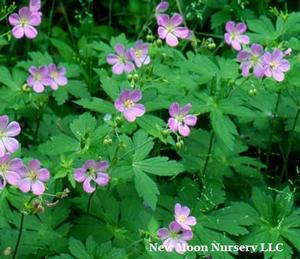New Moon Nurseries
Geranium maculatum
Wild Geranium (No Advance Orders)
Native to North America
NO ADVANCE ORDERS (NAO) - A selection of plants are NAO-No Advanced Orders. They have proved to be tricky; acquiring propagules, producing them, or getting them through the winter. We only put them on our availability lists when they are ready to ship. No hopes dashed. Plants must ship within 2 weeks or their availability date.
FIRST IMPRESSIONS: Geranium maculatum is a lovely spring blooming wildflower that forms 1-3’ tall mounds. Plants have semi-evergreen deeply lobed leaves. In spring, foliage is crowned by loose clusters of saucer shaped 5 petaled lilac colored flowers. Wild geranium is a fine groundcover for woodlands or shade gardens with moist well drained soil or average garden soil.
HABITAT & HARDINESS: Geranium maculatum occurs in eastern North America from Quebec to Manitoba and south to the Florida panhandle and Louisiana.
This species is indigenous to mesic deciduous woods, alluvial forests, upland woods, savannas, meadows, shaded seeps and rocky glades. Plants occasionally move into moist prairies from adjacent woods.
Plants are hardy from USDA Zones 3-8.
PLANT DESCRIPTION: Geranium maculatum is a mounding rhizomatous perennial groundcover.
Flowering stems and basal leaves emerge directly from the rhizomes. The leaves are semi-evergreen, opposite and up to 5” wide. They are palmately cleft with 3-5 deep toothed lobes. The leaf surface is medium green and pubescent. The petioles are long and pubescent with green to reddish color.
From late spring to early summer, the flowering stems are topped by loose rounded cymes containing 2-5 florets. Each floret is 1-1.5” across with 5 rounded petals. The petals are pale pink to lavender with darker veins.
After flowering, distinctive capsule fruits form. The fruit is beak-like and about 1” long. As it matures, the carpels retract and the tiny seed are expelled away from the mother plant.
Plants grow 1-2’ tall with a 1.5’ spread. They often form colonies from underground rhizomes.
CULTURAL & MAINTENANCE NEEDS: Geranium maculatum flourishes in shaded or partly shaded sites with moist well drained soil.
Plants tolerate loamy, sandy or poor infertile soils, acidic pH, short term drought and full sun if sufficient moisture is present.
Plants are fairly pest resistant but are occasionally browsed by deer and other herbivores.
LANDSCAPE USES: This is a good Groundcover for a Wildlife Garden or Shade Garden. Plants are also used as Pollinator Plants or as part of a Grouping or Mass Planting. Geranium maculatum has Showy Blooms, Attractive Foliage and is appropriate for Cottage Gardens, Low Maintenance Plantings and Perennial Borders.
COMPANION & UNDERSTUDY PLANTS: Try pairing Geranium maculatum with Aquilegia canadensis, Carex albicans, Carex plantaginea, Phlox divaricata or Polystichum acrostichoides.
The exotic Geranium macrorrhizum 'Bevan's Variety' has similar appearance and culture and could be substituted in some garden situations.
TRIVIA: Bumblebees, mason bees, cuckoo bees, long horned bees, Halictid bees, Andrenid bees and other native bees visit the flowers for nectar and pollen. The blooms also attract pollinating flies, butterflies and skippers. Plants host the caterpillars of several moth species. Eastern chipmunks and some birds feed on the seed. Deer and other herbivores sometimes browse new leafy growth.
The generic name is from the Greek word geranos which means “crane” and refers to the bill-like fruit capsule. The common name “cranesbill” also refers to the similarity between the fruit and a crane’s beak.
The entire plant was once used to make a medicinal tea that was used to treat diarrhea, inflamed gums and sore throat.
Height:
1-2 ftSpread:
1-2 ftSpacing:
18-24 inUSDA Hardiness Zone:
3-8Bloom Color:
Pink-violetGeranium maculatum Characteristics
Attracts Wildlife
- Pollinators
- Butterflies
Attributes
- Fragrant
- Drought Tolerant
- Cut Flower
- Naturalizing
- Ground Cover
Exposure
- Full Sun to Partial Shade
Deer Resistant
- Deer Resistant
Flowering Months
- May
- April
Foliage Color
- Green
Growth Rate
- Medium
Season of Interest (Foliage)
- Spring
Soil Moisture Preference
- Dry to Moist
- Dry
- Average
- Moist/Well-Drained
